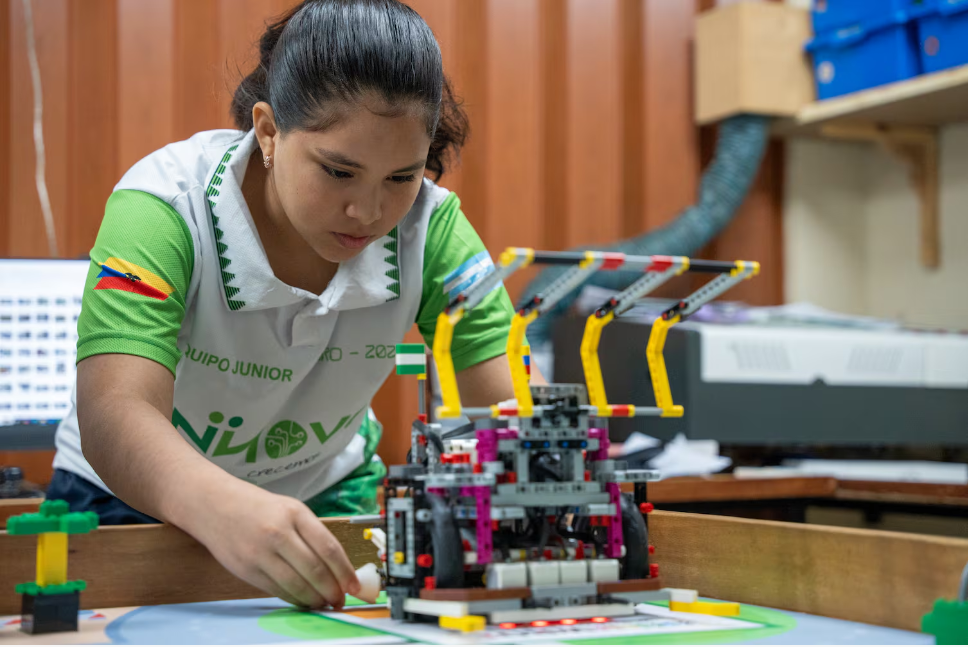
A study by Espol in Guayaquil indicated that only 19% of Ecuadorian women work in the areas of engineering, industry and construction.
From Nueva Prosperina, one of the most dangerous areas of Ecuador, located in the port city of Guayaquil, a group of girls will compete in the Robotics World Cup after having designed and programmed their prototypes, a milestone within their troubled district, marked by the violence of organized crime gangs.
When Valeria Sancán was 8 years old, she saw her older brother, 15, leave Ecuador to represent the country in a Robotics World Cup and decided that she wanted to do the same.Play Video
Seven years later, he says that his life has changed and that he no longer wants to be a chef, but instead dreams of programming, making prototypes and pursuing a career in the world of computing and robotics.
“I find this incredible because it shows that we can give our best and that we all have the ability to learn and develop as we are,” the girl told EFE .
Sancán is one of three girls and teenagers who, along with three other boys, will travel to Turkey in November to participate in the World Robotics Olympics (WRO) with the help of the Innova program, of the Hogar de Cristo organization, which has been working for ten years to reduce the digital divide in this sector of northern Guayaquil.
“I feel nervous and happy because I never thought I would be chosen for this. I am proud of myself,” added the girl, who is working on perfecting the prototype with which she hopes to triumph in the world championship.
Her mother, Soledad Vera, cannot hide her happiness and said that entering this program helped her daughter improve her academic performance, because now she “excels in her classes” because she has the knowledge to face the last years of school, in which she chose computer science as her specialty.
References for other girls
Andrea Quito is the youngest of the team, but at 14 she already knows that she will not be a doctor as she had hoped when she was younger, but rather she will get involved in technology. “I like this type of career, and there are more opportunities,” she said.
She said she was happy because she could be a guide for other younger girls, “who don’t know anything about this subject.” “It makes me happy because I can give them advice on things they didn’t know they could achieve,” she said.
Gandhy Sánchez, coordinator of Innova, explained that this is the first time that the teenagers have gone to the national and international competitions in which this team has participated since 2015.
In 2016, they began to receive the first minors as part of a pilot that sought to promote the entry of girls into the areas of science, technology, engineering and mathematics, known as STEM.
“At the beginning there was a higher percentage of boys, but the difference has been reduced to 55% (boys) and 45% (girls),” she said. Currently, 90 girls and 124 boys are participating in the program.
“What we want is for them to fall in love with the process and have the same opportunities to choose what they want to be in the future,” Sánchez said.
“At first, many want to be nurses, doctors, teachers, and when they finish the cycle (they want to continue) Mechatronics Engineering, Industrial Engineering… and sometimes we have someone who wants to be a biophysician,” she added.
Living in the most violent sector of Guayaquil
A study by the Escuela Superior Politécnica del Litoral (Espol) in Guayaquil found that only 19% of Ecuadorian women work in engineering, industry and construction, while 38% work in natural sciences, mathematics and statistics.
These numbers drop when it comes to women from low-income households, who are less likely to pursue a STEM degree, as is the case for those living in Nueva Prosperina.
In addition, in 2023 this sector closed with a rate of 114 violent deaths per 100,000 inhabitants, one of the highest rates on the planet, and so far in 2024 it remains at the head of the most violent sectors of Guayaquil, according to data from the Municipality, in a context in which more and more children are recruited by organized crime gangs.
“When we talk about the project working here, many people see it as something dangerous, but Hogar de Cristo offers a safe space and the communities and families know it. The girls come and find a playful space and, above all, a space where they can learn many skills,” concluded Sánchez.





